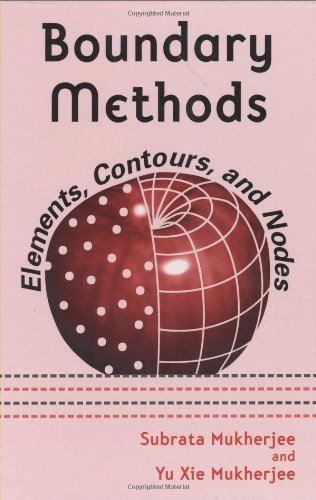(Ebook) Boundary methods: elements, contours, and nodes by Subrata Mukherjee, Yu Xie Mukherjee ISBN 9780824725990, 9781420027860, 0824725999, 1420027867
------------------Description-------------------- Boundary Methods: Elements, Contours, and Nodes presents the results of cutting-edge research in boundary-based mesh-free methods. These methods combine the dimensionality advantage of the boundary element method with the ease of discretization of mesh-free methods, both of which, for some problems, hold distinct advantages over the finite element method. After introducing some novel topics related to the boundary element method (BEM), the authors focus on the boundary contour method (BCM)-a variant of the BEM that further reduces the dimensionality of a problem. The final section of the book explores the boundary node method, which combines the BEM with moving least-squares approximants to produce a mesh-free, boundary-only method. The authors, who are also the primary developers of these methods, clearly introduce and develop each topic. In addition to numerical solutions of boundary value problems in potential theory and linear elasticity, they also discuss topics such as shape sensitivities, shape optimization, and adaptive meshing. Numerical results for selected problems appear throughout the book, as do extensive references. ---------------------Features--------------------- · Introduces novel computational methods that combine the advantages of the boundary element method with those of mesh-free methods · Includes numerical results for many of the problems discussed · Explores applications such as shape sensitivity analysis, shape optimization, and error estimation, analysis, and adaptivity ---------------------Contents--------------------- INTRODUCTION TO BOUNDARY METHODS I SELECTED TOPICS IN BOUNDARY ELEMENT METHODS BOUNDARY INTEGRAL EQUATIONS Potential Theory in Three Dimensions Linear Elasticity in Three Dimensions Nearly Singular Integrals in Linear Elasticity Finite Parts of Hypersingular Equations ERROR ESTIMATION Linear Operators Iterated HBIE and Error Estimation Element-Based Error Indicators Numerical Examples THIN FEATURES Exterior BIE for Potential Theory: MEMS BIE for Elasticity: Cracks and Thin Shells II THE BOUNDARY CONTOUR METHOD LINEAR ELASTICITY Surface and Boundary Contour Equations Hypersingular Boundary Integral Equations Internal Displacements and Stresses Numerical Results SHAPE SENSITIVITY ANALYSIS Sensitivities of Boundary Variables Sensitivities of Surface Stresses Sensitivities of Variables at Internal Points Numerical Results: Hollow Sphere Numerical Results: Block with a Hole SHAPE OPTIMIZATION Shape Optimization Problems Numerical Results ERROR ESTIMATION AND ADAPTIVITY Hypersingular Residuals as Local Error Estimators Adaptive Meshing Strategy Numerical Results III THE BOUNDARY NODE METHOD SURFACE APPROXIMANTS Moving Least Squares (MLS) Approximants Surface Derivatives Weight Functions Use of Cartesian Coordinates POTENTIAL THEORY AND ELASTICITY Potential Theory in Three Dimensions Linear Elasticity in Three Dimensions ADAPTIVITY FOR 3-D POTENTIAL THEORY Hypersingular and Singular Residuals Error Estimation and Adaptive Strategy Progressively Adaptive Solutions: Cube Problem One-Step Adaptive Cell Refinement ADAPTIVITY FOR 3-D LINEAR ELASTICITY Hypersingular and Singular Residuals Error Estimation and Adaptive Strategy Progressively Adaptive Solutions: Pulling a Rod One-Step Adaptive Cell Refinement Bibliography Index
*Free conversion of into popular formats such as PDF, DOCX, DOC, AZW, EPUB, and MOBI after payment.


